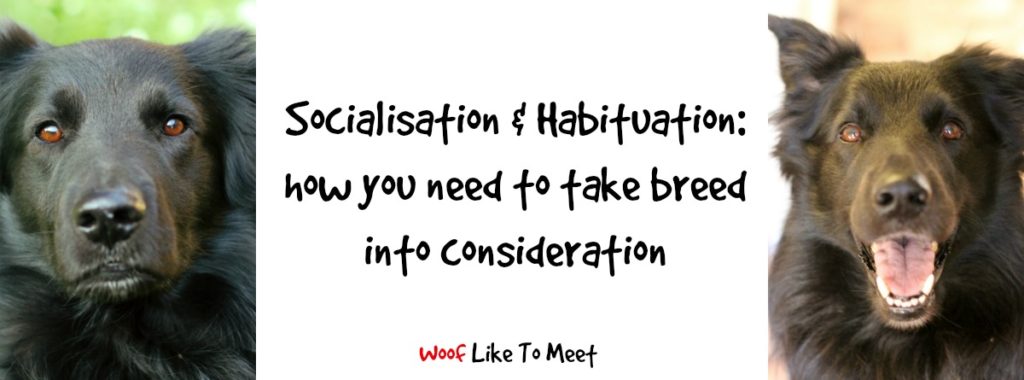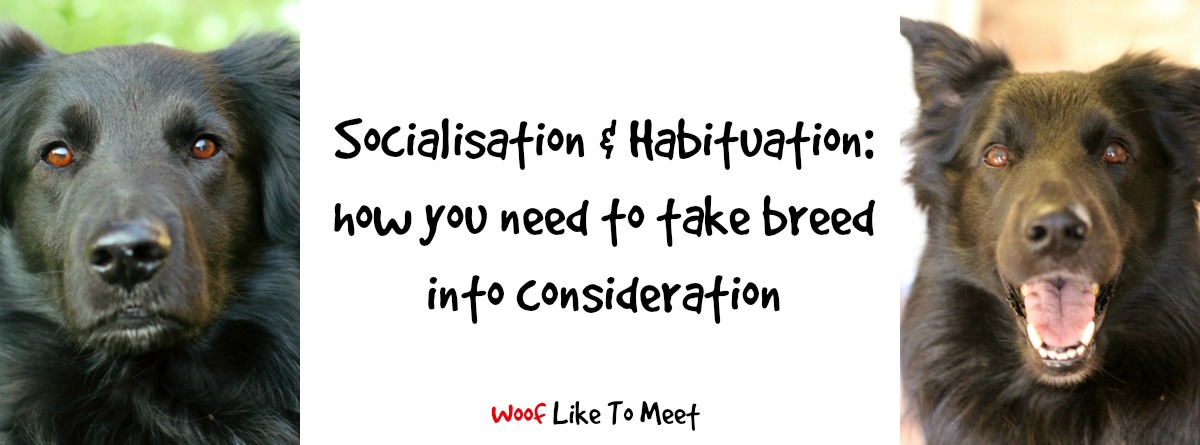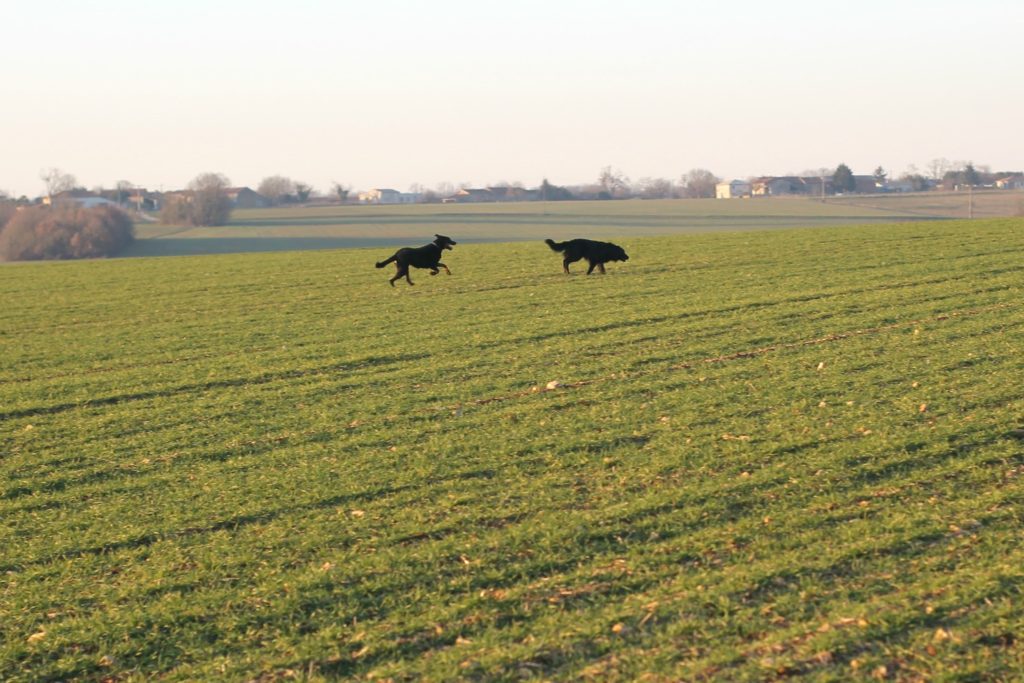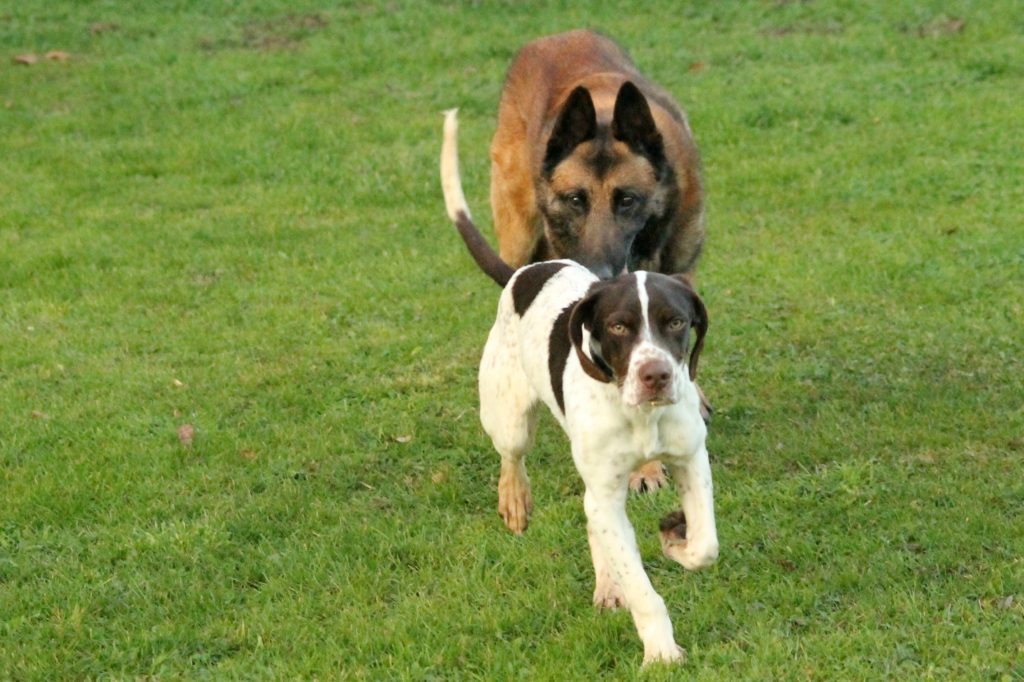
Last week, I posted about socialisation, habituation and the difference between them. This is in response to a particularly ‘contagious’ post doing the rounds about why you don’t need to socialise your dog. I think she meant why you shouldn’t flood your young puppy and overwhelm it with stimuli – which I agree with – but I’m very much in the ‘yes you do need to both socialise and habituate your dog’ camp – because I work with problem dogs who haven’t had the basics they needed, and because I know what has gone awry.
When you hang around animals, you can see those who aren’t used to other dogs, those who haven’t been socialised with other dogs, those who are not used to humans and those who have been accidentally sensitised rather than getting used to it.
Breed is a factor in that. It’s the basic ingredients that your dog comes with. What you do with those ingredients depends on what you get as a ‘finished product’. That’s the socialisation, habituation and training bit. They’re the recipe and the cooking.
I also wrote about my own dog, Heston, who I raised as a gundog and who turned out to be a shepherd mix with a little bit of gundog, rather than a retriever/collie mix with no shepherd. When I got his DNA test back, it explained some of his worst habits, things that ‘shepherds gone wrong’ are likely to show, as well as ‘shepherds gone right’. I wrote about how training had turned him into a pretty great gundog. What I didn’t write about was how his lack of appropriate socialisation and habituation had turned him into a pretty bad shepherd.
What does that mean?
I mean, I’ve worked with my fair share of shepherds gone wrong.
What you find are what I’d call excessive breed tendencies.
What that means are all the behaviours that prize-winning shepherds have a little bit, that you can refine and shape, and that haven’t been shaped in others who end up on my books, or on my couch.
If you look at dog competitions like mondioring, French ring, Schutzhund, IPO etc, you see shepherds with these breed tendencies on cue. I’m not talking about the tracking, trailing or jumps. Those are things that other dogs do too. I’m talking about the things that make these competitions almost exclusively dominated by one breed or one group of breeds. I’m talking about behaviours which are more instinctive to your average shepherd than they are to your average spaniel. That’s to say they are doing what they usually do, just it’s under control. Those excessive breed tendencies show up, under control, in chasing a fleeing stranger, facing down an aggressive stranger, defending the handler, taking down someone who is running away and guarding an object. That’s to say more likely than a foxhound, for instance, to be territorial, to confront strangers, to be wary of new stuff, to be unfriendly around other predators (including dogs and humans) and to be capable of protecting something they consider as ‘theirs’. You’ll see these show up on reviews of James Serpell’s CBARQ assessment, which compares breed tendencies. I’m always a little cautious because surveys such as CBARQ do play into the owner biases, but I think there is enough work to show that those biases have a basis in the behaviour we see. Just as an example: the problems we get with the hounds in the shelter are different than the problems we get with terriers or shepherds. So be super cautious of breed stereotypes, but know that there’s something to bear in mind… it’s why dogs do different jobs and why they excel in different competitions. Who wins field trials? I’ll give you a clue. It’s never been a Jack Russell.
Those shepherd breed tendencies seen in ring competitions also show up, not under control, in dogs who chase or ‘intercept’ joggers or cyclists, dogs who will charge up to a stranger, circling them and barking, biting if they make any movement, dogs who won’t tolerate a stranger coming into the perimeter of the owner or home, dogs who bite you as you’re moving away and dogs who are excessively territorial or have excessive resource guarding habits.
The difference between those who have the behaviours under control and those who don’t depends on a lot of things.
It depends on the emotion. Heston running up to and cornering a guy who’d come onto my property ‘to look for scrap metal’ had the emotional intensity that some top competitions look for. He didn’t look like an R+ trained dog playing a find-the-intruder game. Dogs on cue probably won’t do it with the same emotion. He did everything that competition dogs do – just without me asking unfortunately. He ran up, he held the guy in position, he barked fiercely and angrily. When the guy tried to move, he circled him. When the guy yelled at him, Heston barked more intensely. There was no contact. He did everything a mondioring dog does – without training. Now, I’m not proud of this and it’s not a “whoo, look at my untrained dog’s skills”. I am just saying that in competitions, you see the same behaviours, just without the self-employment bit. A trained dog does it as a simulation. An untrained dog does it for real.
What’s the difference between this:
And Heston finding a stranger in the garden?
Control. Training. Teaching. Cues. Handling. Management of emotion. Impulse control.
I am in no way condoning these behaviours. He could well have done them with a person who had every right to be on the property. I had to go over and physically restrain my own dog. I don’t think it is in any way an acceptable behaviour, and once I’d seen it, I manage the situation much more carefully and we’ve done a lot of training around strangers – though less than I’d like about ones who come on to the property, just because of the nature of my lifestyle. One self-employed moment was more than enough. I had no way of knowing he would do this with a stranger on my property. I hated that moment. I looked back on how it had come about and how I could prevent it. Just because I have no doubt that the man was scoping my property for whatever he could take doesn’t make it acceptable. It is the worst side of my dog – the one that brings me the most heartache. But he is just doing the same behaviours as a great, well-trained shepherd – just in an entirely real scenario – luckily without the biting and sadly without the impulse control.
The difference between good and bad is whether the behaviour is under stimulus control or not. By which I mean you have to give permission for it to start and you have to tell the dog to stop and they do. A ‘good’ shepherd will win competitions. A ‘bad’ shepherd will end up with a euthanasia order for biting a passing jogger who got in range.
A lot goes into ‘good’ dogs vs ‘bad’ dogs. There are so many factors that influenced that moment with Heston that is impossible to extrapolate a single cause.
Is it the ingredients?
Is it because he came from a line of ‘off the book’ Groenendael Belgian shepherds whose owners probably didn’t care much about pedigree, history and temperament?
Is it parental?
Since I don’t know his history, I don’t know for sure. I do know there aren’t any groenendael breeders in the area he was found. There aren’t even any registered single dogs. That means ‘off the books’. I have the same small feeling of anxiety with every malinois, every GSD who comes in without ID. No ID means no traceable pedigree. No traceable pedigree means no predictable behaviour from family lines.
Since I don’t know his lines and I don’t know his parents, I can’t say. They could be practically feral and foaming at the mouth. They could be really sweet. I don’t know and will never know.
Is it the early mixing of those ingredients?
Is it his birth order or pre-natal experiences? Dogs’ positions in utero can affect testosterone levels. In utero stress can also lead to fearfulness. Is that aggression rooted in fear?
Is it because he is male? Testosterone and aggression have links that science is only just beginning to get in to.
Is it because he is entire? But being castrated can also increase aggression rooted in fear.
Is it in the recipe that’s made him into the dog he is?
Was it being hand-raised with only one of his siblings?
Was it the time at 9 weeks when one of my neighbours walked in when he was eating? He barked and barked at her and it was definitely his first ‘stranger danger’ moment. Before that, he had been great with strangers.
Was it the fence-running GSD of my neighbour who I had to get past to take him on a walk, and who barked every time any time anyone moved in my garden?
Was it the time I took him to a festival and it overwhelmed him?
Was it the time he was subject to a very threatening welcome by a number of other dogs at a barbecue?
Is it the fact I live alone and he just doesn’t experience other humans than me often enough?
Is it the fact that he really only met about ten dogs in his first six months?
Did he pick it up off Tilly, my other dog, who is reactive and fearful of strangers, who barks when people come on the property and who is also nervous with other dogs?
Is he just doing a self-employed version of the beautiful Dubion Ebony?
The fact is there are so many factors that could have contributed to that moment of excessive breed tendencies. As with all behavioural issues, a post-mortem of their cause is not particularly useful. We can pontificate all day on the whys. What matters is the what we do with what we actually have in front of us.
No good shutting the door after the Groenendael has pinned a stranger, so to speak.
That said, if you can reduce the whys, you’re going to find you can moderate what you end up with.
You can counteract excessive breed tendencies. And you should.
When you know that you have a dog of a particular breed, then it is your job when you raise it to make sure the socialisation and habituation meets the needs of the dog and prepares the puppy for situations in which you are likely to see those excessive breed tendencies. This is as true for my American cocker spaniel Tilly as it is for Heston. She came to me aged five with a handful of wholly predictable behaviours that could have been counteracted through living in the appropriate home and with the appropriate socialisation and habituation as a youngster.
It wasn’t a surprise that Tilly would urinate submissively on greetings. My grandparents had had an American cocker spaniel almost thirty years before who had done the same. It also wasn’t a surprise that she would steal food. Sunny had done the same. If you have a breed of dog who can be excessively fearful around strangers, then that’s something a good programme of socialisation can help the dog with. If you have a dog who is nervous with strangers, that is something they can learn not to be. If you have a dog from a breed known for resource-guarding, then teaching ‘trade’ and ‘give’ is fundamental. Sadly, Tilly’s early vet notes show she had already developed these habits by the time she was 6 months old and had seen a specialist already about them. It wasn’t a surprise to see them re-emerge under stress when she moved house and family.
When you get those early experiences right, instead of having those heart-stopping moments where your dog does something horrible, you end up with dogs who buck the trend. Flika, my current Malinois foster, and Tobby, my old Mali guy who died in 2016 are a case in point. They are both super-social, really friendly and would never, ever exhibit the kind of behaviours that I have seen in Heston. They are how shepherds should be. Heston doesn’t like people. He moves away from strangers and comes back to me when he is feeling nervous. He is super-friendly with his ‘inner circle’ – people who he’s known for more than 24 hours on home territory – but he is visibly uncomfortable and stressed where Tobby wasn’t and Flika never is. All shepherds. All with the same basic ingredients and the same behaviours.
They pop out in ways that you don’t expect. Like Effel with his lawnmower chasing, and his Heston chasing…
Or Tobby with his obsession over a hound
And Flika when she saw a car moving in the distance and belted off to go and investigate.
How do you get away from these inbuilt behaviours? You habituate your shepherd to unfamiliar moving things. You take your young beauceron and you teach him impulse control around moving stuff. You take your Belgian shepherd and you get him used to seeing all kinds of running dogs. A clear, sensible programme of gradual and systematic habituation nips problems in the bud better than just saying, “Naughty dog!” after they’ve done nothing more than the behaviours they were born with.
It’s not just about chasing moving objects or whether or not they are social towards unfamiliar humans. And it’s not just about herding breeds or livestock guardians.
It’s not just about the predatory motor sequence either. Flika and Tobby aren’t just super social. Tobby formed an easy attachment to me, just as the beauceron Effel did, and just as Flika has. That’s another thing about shepherds. Loyal. They are your shadow. Our shelter boss always says it’s the beauceron shepherds who find it hardest at the shelter. She says they cry for days when abandoned. Until they find a new owner, sure. I think it took Effel a couple of days to shift to his new owner. Flika, well, within a week she was watching for me out of the window. Excessive breed tendencies aren’t always about aggression. They can also be other known behaviours which can be problematic: restless Brittany spaniels, excessively vocal terriers, predation in hunting breeds, hyperactivity in springers, aloofness in Akitas, guarding in some terriers or spaniels.
Sadly, once that socialisation and habituation window closes around three months of age, you are left with a dog who will always be ‘remedial’, who will always be playing catch up. Not impossible, but not so easy. Those early patterns become ‘myelinised’ and the brain starts laying down strong pathways for some behavioural patterns, whilst ‘pruning’ others. It’s not just about the more a behaviour is practised or not: it’s about the brain setting some of those patterns in cement. Yes, cement can be broken. You can dismantle a reinforced concrete wall with a lot of effort. But it’s much nicer if it’s a plywood partition wall. It’s even better if there’s no wall there in the first place and you can build behaviours how you want.
This was patently clear last night when I watched a video on Facebook that a trainer had posted. It was her lovely cockers doing their cocker thing and minding their own business. They were then ambushed by a West Highland Terrier who charged up and bit one of them as he left. The westie had been on lead and I’m not sure what had happened to cause the dog to get away, but that right there – biting the rear end of a retreating creature – is one excessive breed tendency that could have caused a lot of heartache. If you have a terrier and you know they can be difficult around other dogs, that they need plenty of positive habituation to dogs passing, dogs moving and dogs doing their doggy business, then it is your absolute duty to teach them that when it is young enough to become instinct. Otherwise, you are left managing your dog’s behaviour and never truly overcoming their worst, most anti-social habits. You end up with a dog permanently on lead, muzzled, who doesn’t enjoy walks in the park.
So how would my ideal S&H programme have differed for Tilly, Heston and Flika?
For Heston, my ‘stranger danger’ shepherd… He would have had lots more dog experience – all planned, careful and under threshold. I would have had a happy and steady stream of planned visitors to my property every single day being careful never to overwhelm him. I would have conditioned him not to be afraid of the GSD in the garden next door. He would have met many more dogs and I would have taught him how to respond to seeing strangers or strange dogs by coming back to me. I would have been all about impulse control and looking to me for leadership. I managed the bite inhibition fairly well (well, you do a lot of retrieves when you think you have a retriever!) and he had at least some positive experiences with strangers and other dogs, but not enough. I do wonder to myself if he doesn’t bite – and he never has, not even when faced by curious would-be thieves – because Groenendaels are not so good at the biting bit (and why Malis and Dutch shepherds rule at ring sports) and whether even the fact he doesn’t bite under attack is just the luck of the draw.
For Tilly, my guardy, grumbly cocker… she needed a proper programme to habituate her to handling, to husbandry, to ear checks and grooming. She needed to be taught ‘trade’ over and over. She needed to have a very gradual, gentle programme by which she learned not to be afraid of strangers. She needed confidence and to be taught how to make space if she is feeling nervous. She needed a secure base. Sadly, rehoming and bootcamps are not conducive to secure bases, and grabby children taking your toys are not conducive to feeling safe with your stuff.
For Flika, my separation-anxiety Mali… she needed (as now) to be habituated to time without her owner. She needed to be taught some independence and strategies for being on her own. She needed to be taught that absence is nothing to be worried about and that escape to find your owner is not necessary. Sadly, for dogs who can’t cope without their owner, they often end up being rehomed – which gives them a real event to add to their anxiety. Flika is on her sixth home that we know of. Do you think that, at 13 years old, those rehomings have made her feel any less anxious about being left by her family group?
We fail our dogs every day by not understanding their innate behaviours, their strengths and their weaknesses. It is never an excuse that a terrier bites the rump of a retreating cocker, that a spaniel guards a mouldy bread roll, that a shepherd corners a stranger and barks at them. We know very well that these behaviours exist in our dogs and which traits are more likely or less likely. Good breeders are taking these things seriously, and you won’t find nervous or highly-strung American cockers being bred by one of my friends, or guardy, grumbly English cockers being bred by another. When we get a puppy, it’s our absolute duty to use those early weeks to balance out what Mother Nature has given us, rather than saying “Oops, Sorry!” when it is far too late to effectively address that behaviour.
I did so well by Heston in so many respects. He is independent without being destructive. He handles absence. He is easy for me to handle. He loves being groomed and handled. He has appropriate ways to expend his energies that don’t involve chewing, digging or escaping. But in others, I let him down. It’s all very well to look back and understand why I let him down – and now it’s very much a management of behaviours rather than anything else – but we can’t keep making mistakes by not socialising or habituating our dogs properly.
I’ll finish by referring to John Rogerson. He is not a trainer I refer to often. But I believe one thing he said is true… that we should be running breed-specific puppy classes by experts in those breeds. Or at least, group-specific classes. One size does not fit all where socialisation and habituation is concerned. Honestly, I’d go a bit further and say it should be personalised to the home and the environment too – since adult dogs are as much a product of those factors as they are of their breed. I don’t believe breed is everything. I don’t believe that once you get a GSP that you are setting yourself up for hyperactivity or separation anxiety, or if you get a Westie, you are setting yourself up for life on the lead in case they grab a retreating animal. I know plenty of dogs who buck the trend.
Why is it that they buck the trend?
That is due to great breeding programmes and careful socialisation/habituation in their early weeks.
The ingredients that you get don’t come with one single recipe that you have to make.
All the same, if we want to eradicate those excessive breed tendencies, we need a careful stewardship of breeding AND a carefully-constructed programme that teaches our puppies how to behave when interacting with familiar and unfamiliar humans, as well as familiar and unfamiliar dogs. Not only that, we also need to habituate them to the life they will lead and make sure they don’t accidentally end up chasing the first bike they see, aged six, or biting the lawnmower aged seven.
When we address genetic history, individual history and early learning together, we have a powerful way to get dogs who won’t find living in the human world to be quite so difficult.
That’s our responsibility in our stewardship of dogs. It’s our responsibility as a breeder. It’s our responsibility as an owner. We owe it to our dogs to understand them and to help them adjust to the world in which we ask them to live.
If we did these things, we’d have far fewer moments where dogs struggle to meet our expectations.
A lot to ask for, I know.



